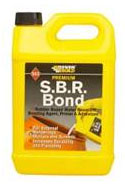PVA or Polyvinyl Acetate is, in its simplest form, glue for sticking pieces of paper together. One step up the ladder, and a little stronger, it becomes an excellent wood glue for DIY enthusiasts and joiners alike. In its extreme, big boy/girl form it becomes an extremely versatile, waterproof adhesive and sealer, which has an extraordinary number of uses in the building trade.
PVA in Cement and Mortar
PVA can be added to a cement mortar mix to give the mix a) slightly better waterproofing qualities and b) advanced adhesion to the surface it is applied to. Painting a coat of PVA on the surface before the cement mortar is applied can even further increase this adhesion.
PVA and Uses With Timber
Timber can be sealed with PVA to give it a waterproof quality, although if the surface of the timber is to be subject to any wear or traffic, then PVA, as it is an emulsion, will eventually fail. Similarly we do not recommend using PVA as a sealer on walls that are to be over painted with emulsion paints. PVA can also be used to allow ceramic tiles to stick to timber (bath panels etc). At least 3 coats of undiluted PVA are required and each coat must dry thoroughly before the next is applied.
Sand, Cement and PVA Mix
To use in sand and cement, a mixture of 2 parts PVA to 1 part water is general. Tip the PVA in the water and mix as normal. PVA dries to a colourless finish and will not react with any other surface preparation or finish.
Paint the surface with a coat of PVA before application of the mortar. It can be applied undiluted for maximum sealing and/or adhesion, or diluted as above. The mortar or render is best applied when the PVA is slightly tacky. This gives it the best adhesion and because it has yet to dry and become totally waterproof, will still allow the natural porosity of the surface to assist in drying out the mix you are using. If the PVA is dry, the surface will not be able to "suck up" any of the moisture in the mix and it will take longer to dry.
PVA and Absorbant Surfaces
PVA is used to coat extremely absorbent surfaces before the application of a finish which will dry out too quickly to work on if it were applied direct. For example, when plastering over an existing artex ceiling the moisture in the plaster would be soaked up so quickly that the plaster would be rock hard in minutes and getting a smooth finish would be impossible. Sealing the surface with PVA slows down this moisture absorption and allows the plaster to remain workable for longer.
PVA can simply be painted onto any surface, but as it is water based and needs to be absorbed, it will not stick two non–absorbent surfaces together.
An important point to make is If the surface you are working on is external and likely to be washed with rain regularly, PVA is not the best product to use. For external use we recommend using SBR Bond which is much stronger and also stable in Freeze-Thaw conditions.Please also see our project on Freeze and Thaw action.

SBR Bond 5 Litres

